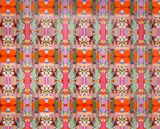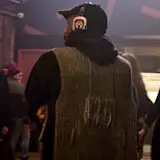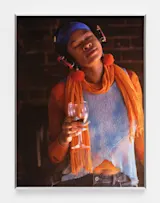Crop Over, 2007 , Video
- Medium
- Two channel HD colour video with sound and printed wallpaper.
- Dimensions
- Dimensions variable. Duration:15 minutes.












The Crop Over carnival is a harvest festival, which historically marks the end of the sugar cane season in Barbados but originates out of the conditions of plantation life and sugar production in the Caribbean.
Crop Over is also a response to the history of Harewood House in the UK, and its relationship to the trans-Atlantic slave trade. The film begins at Harewood House, built by Edward Lascelles, who made his wealth in Barbados and Jamaica by trading in plantations and slaves. A stilt walker wanders through the majestic gardens, confidently negotiating the grounds of the beautiful English country house.
Then, we are transported to the brooding skies that hang over the sugarcane fields in Barbados and to the splendour of a plantation house. The plantation house echoes the grandeur of Harewood but is surrounded by an avenue of exotic palm trees, a pool of water lilies, and lotus flowers, drawing parallels between the cultivated landscapes of both Barbados and Britain- a reminder of who owned, worked on, and now enjoys these different landscapes.
The Crop Over festival comes out of the convergence of these different histories and spaces. As the film unfolds, cultural historians’ comment on the folk characters associated with the festivities; Donkeyman, Mother Sally, Shaggy Bear and Stilt Walker, as these folkloric figures occupy both Harewood House and the plantation house in Barbados with their improvised performances. Folk characters would never usually be seen inside plantation houses and the act itself is considered by locals to be transgressive.
The contemplative nature of the film then changes, as we are taken directly to the pinnacle of the Crop Over festival, Grand Kadooment Day. Surrounded by Mas bands, dancers and street revellers, we are submerged into the heady world of masquerade and the carnivalesque.
Wallpaper series

Silhouette
2025

Mid Century Optimism
2025

Geo-Candy
2025

Entering the Disco
2025

Clapping Wallpaper 2
2024

Braided Wallpaper
2023

Coloured Wallpaper
2023
FEELING HER WAY
2022

Ain't Misbehavin'
2022

We move in her way
2017

Just One Minute More
2016-2022

Devotional Wallpaper and Placards
2008 - 2018

Crop Over
2007

Lover's Rock
1998

Head I (Skin) / Head II (Dread)
1995

They're Almost Like Twins
1995

Clapping Wallpaper
1994
Related theme: Performance

Merriment Lights
2025

Very dark Ope
2025

Backlit
2025

Blue jacket
2025

Man, glass of wine
2025

Michael & swishing braids 03
2025

Entering the Disco
2025

Bridie's daughter (Yewa)
2025

Dancers cast silhouette
2025

Grey Jumper
2025

Purple Lights (Lisa)
2025

Hands up
2025

Michael & swishing braids 02
2025

Ope
2025

Silent Disco
2025

Silhouette
2025

Two in motion together (Ere & Toyin)
2025

Michael & swishing braids 01
2025

Judah
2025

Orange scarf (Sola)
2025

Green light (Kate)
2025

Selina
2025

Put Your Hands Together
2024

BENEVOLENCE
2024

In the Mix: Disciples Together
2022

On My Way
2022
FEELING HER WAY
2022

In the Mix: Shirley Songs
2022

In the Mix: Skunk Sputnik
2022

Ain't Misbehavin'
2022

In the Mix: Hippy Liberty
2022

Yes, I Hear You
2022

Family Gorgeous Smudged
2022

In the Mix: Mel & Kim Respect
2022

In the Mix: Alexandra B’s Dress
2022

P. P. Arnold / Just call me angel of the morning
2021

Miss Elizabeth Welch 1933 – 1940 / a nightingale sang in Berkeley Square
2021

Sheila Chandra / Ever so lonely MONSOON
2021

Shirley Bassey / Goldfinger
2021

Sade / The Sweetest Taboo
2021

Polystyrene / X-ray Spex OH BONDAGE UP YOURS!
2021

Six Acts
2018

The Audition
1997 - printed 2018

We move in her way
2017

Just One Minute More
2016-2022

Paper Tiger Whisky Soap Theatre (Dada Nice)
2016

Exquisite Cacophony
2015

Move
2013

Dance of Belém
2011

Gather:Justicia
2010

Oh Adelaide (with Ain Bailey)
2010

Taken
2009

Devotional Wallpaper and Placards
2008 - 2018

Drift
2008

For you, only you
2007

Crop Over
2007

Exquisite Tension
2006

1930s to 1960s – The Rivington Place Portfolio
2006

Devotional II
2005

Devotional, 2004
2004
Related theme: Participatory / Collaboration

Very dark Ope
2025

Blue jacket
2025

Backlit
2025

Man, glass of wine
2025

Michael & swishing braids 03
2025

Entering the Disco
2025

Bridie's daughter (Yewa)
2025

Dancers cast silhouette
2025

Grey Jumper
2025

Silhouette
2025

Purple Lights (Lisa)
2025

Hands up
2025

Michael & swishing braids 02
2025

Judah
2025

Green light (Kate)
2025

Two in motion together (Ere & Toyin)
2025

Michael & swishing braids 01
2025

Orange scarf (Sola)
2025

Silent Disco
2025

Selina
2025

Ope
2025

Merriment Lights
2025

BENEVOLENCE
2024

Yes, I Hear You
2022
FEELING HER WAY
2022

Ain't Misbehavin'
2022

Family Gorgeous Smudged
2022

In the Castle of My Skin
2020 - 2021

The Audition in Colour
1997 - printed 2020

The Audition
1997 - printed 2018

Six Acts
2018

We move in her way
2017

Paper Tiger Whisky Soap Theatre (Dada Nice)
2016

Exquisite Cacophony
2015

Move
2013

Dance of Belém
2011

Oh Adelaide (with Ain Bailey)
2010

Gather:Justicia
2010

Taken
2009

Devotional Wallpaper and Placards
2008 - 2018

Drift
2008

Crop Over
2007

For you, only you
2007

Exquisite Tension
2006

Devotional II
2005

Devotional, 2004
2004

Tongues
1997

They're Almost Like Twins
1995

Untitled (Kiss)
1995